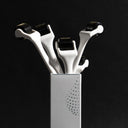Many of us take our hair for granted until one day, we notice it's not as thick or full as it used to be. While hair loss is typically associated with the top of the scalp, it can occur anywhere – including the nape of the neck. This article delves into the potential causes of hair loss at the nape of the neck, helping you understand why it might be happening and what you can do about it.
Table of content
What Causes Hair Loss at the Nape of the Neck?
The main causes of hair loss at the nape of the neck include traction alopecia, alopecia areata, androgenetic alopecia, frontal fibrosing alopecia, heat and chemical damage, acne keloidalis nuchae, and certain hair shaft disorders. Each of these conditions is associated with specific risk factors and triggers, and the appropriate treatment will depend on the precise cause of the hair loss.
As your leading source for hair health information over the past 4 years, we never compromise on accuracy. When it comes to your health, you deserve information you can truly rely on - and earning your trust is our top priority.
Here's how Scandinavian Biolabs ensures every piece of content meets the highest standards of accuracy and integrity:
- Credentialed Experts: Our reviewers are actively practicing doctors and medical researchers
- Stringent Reviews: Content undergoes rigorous editing by subject specialists and review by a practicing doctor.
- Evidence-Based: We rely on well-established research from trusted scientific sources like peer-reviewed journals and health authorities.
- Full Transparency: Our editorial standards, writer credentials, reviewer credentials, correction process, and funding are all publicly documented.
- Independent Voice: While we do promote products, we operate in a vacuum to business operations. Our main goal is just an unwavering commitment to providing medically-sound guidance.
You can count on Scandinavian Biolabs to consistently deliver the trustworthy health information you deserve. Read our Editorial Standards.
Traction Alopecia: Hair Under Stress
Traction alopecia is hair loss resulting from the tight pulling of hair. Hair styling practices such as tight ponytails, braids, and weaves can cause this type of hair loss. If caught early, hair regrowth can occur even without treatment. However, if the traction is prolonged, the hair loss can become permanent. Moreover, some individuals with a condition that mimics traction alopecia actually have a scarring alopecia known as cicatricial marginal alopecia.
Alopecia Areata: An Autoimmune Response
Alopecia areata is an autoimmune disease affecting about 2% of the population globally. This condition can cause hair loss anywhere on the body, including the nape of the neck. The specific form of alopecia areata that results in hair loss at the back of the scalp is known as the 'ophiasis' form. While this form is often resistant to standard treatments, topical steroids, steroid injections, and diphencyprone are typically the first-line treatment options.
Androgenetic Alopecia: Genetic Thinning
Androgenetic alopecia, also known as male or female pattern baldness, typically results in hair loss at the top of the scalp. However, in advancing stages, it can also lead to thinning along the nape of the neck.
Frontal Fibrosing Alopecia: A Scarring Phenomenon
Frontal fibrosing alopecia (FFA) is a type of scarring alopecia that primarily affects women between 45 and 70 years of age. While it typically causes hair loss along the frontal hairline and eyebrows, it can also affect the nape of the neck. Treatments for FFA include topical steroids, steroid injections, and oral medications like finasteride, doxycycline, and hydroxychloroquine.
Heat and Chemical Damage: External Causes
Overuse of heat and chemical treatments can lead to hair shaft damage and subsequent hair loss at the nape. Over time, these factors can contribute to an increased risk of developing traction alopecia.
Acne Keloidalis Nuchae: An Inflammatory Cause
Acne keloidalis nuchae (AKN) is a condition characterized by small, raised bumps along the back of the scalp, often resulting in hair loss in the region. The hair loss associated with AKN is often permanent and can lead to thick and disfiguring scars.
Hair Shaft Disorders: Structural Problems
Finally, certain hair shaft disorders can lead to hair loss at the nape of the neck. Individuals with these disorders have abnormalities in their hair shaft production, which can often lead to hair breakage. Monilethrix is one such disorder that frequently results in hair loss along the nape.
Conclusion
Hair loss at the nape of the neck can be unsettling and frustrating, but understanding the potential causes can help guide treatment decisions. It's important to consult with a healthcare professional or a dermatologist who specializes in hair loss if you're experiencing this issue. They can diagnose the underlying cause of your hair loss and help develop an appropriate treatment plan to manage your condition and support hair regrowth.
Consider enhancing the appearance of your scalp with the Scandinavian Biolabs Hair Growth Routine. Designed to support the look of fuller hair, this routine is based on scientific research and aims to improve the appearance of your hair. Utilize a blend of nature and science to help improve the look of your hair. Consider giving your hair the attention it deserves today.
Read more:




